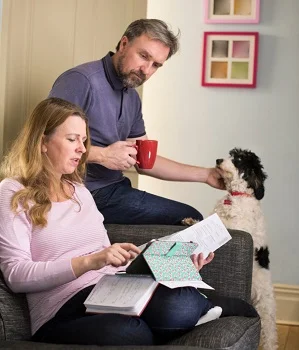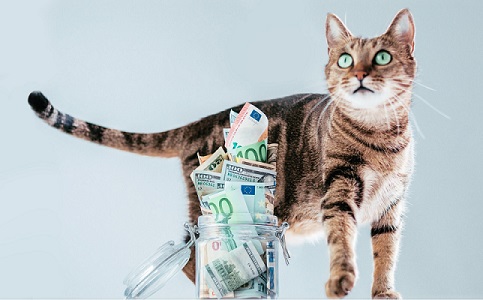Make Room in Your Budget for Fluffy

rebuild your worth, book a free consultation todayBook Now
By Taz Rajan| Reading Time: 4 min, 7 seconds | 825 words
They are excited every single time they see us, they fill our lives with adventure and we absolutely love our furry friends. Many individuals and families added their very first fur baby in 2020, which has proven to be a blessing for many animals that were in shelters and for the mental health and well-being of Canadians!
The addition of any family member brings joy and adventure, and requires a look at our budget and finances. Pets can get costly: according to an annual spending survey, the average Canadian household spent $756.00 on pet expenses in 2019 on food, travel accessories, toys, clean-up products and veterinary care. Can your budget take it?
 |
Table of contents: 1.Time to Review the Budget Again! |
1.Time to Review the Budget Again!
Overwhelming debt from unforeseen pet-related expenses can cause stress and anxiety, so we are talking about a budget again. Although 53% of Canadians do not have a regular budget (according to Canada.ca), it is very helpful in avoiding overwhelming debt. A budget is a spending plan, a financial GPS and an accountability partner. A budget will help you plan, track, execute and pivot financially as needed. One of the first things to do once you decide on adding a pet to the family is add the expenses for your pet into your budget.
Think of regular, fixed costs like food and grooming and add these lines into your monthly budget. Also, think about annual costs like a regular vet bill, specialty grooming, or boarding fees. Finally, set aside some money each month in a separate account to cover any unexpected costs, like an illness or injury. It’s important to have a plan to cover such costs without getting into debt for your pet.
2.Common Pet Costs
Generally speaking, the first year of pet ownership is the most expensive. There are many up front purchases and costs that come through such as adoption fees, vet appointments, equipment for your home and vehicle, and of course, spoiling them with all the treats and toys.
The Ontario Veterinary Medical Association has an excellent break down of costs for dog ownership and cat ownership. This as a great starting point for a pet budget, even if you have one of the many other types of pets available today.
Here are some common expenses to consider;
- Food
- Treats
- Toys
- Veterinary Care
- Grooming
- Beds/Crates/Tanks/Scratch posts
- Licenses
- Sitters
- Travel expenses
3.Top 10 Money saving tips for pet owners
Based on our research, here are the top 10 ways to save money while caring for your pet.
- Shop for gently used goods – gently used items can cost significantly less than brand new and are great for the environment.
- Use human versions of pet items -a stainless steel mixing bowl makes a great water or food bowl, a set of 3 Tennis balls from the dollar store makes a great toy.
- Buy in bulk and use discount codes – especially when it comes to pet food.
- Compare prices before you buy – check online, check with various pet stores and ask for a price match.
- Regular vet appointments are important preventative care and can save you money and heartache in the future
- Plan for the unexpected – set money aside each month towards a pet emergency fund for those unexpected vet visits or other expenses.
- DIY treats – make your own pet treats at home. There are many recipes and tips online.
- Save on prescriptions – ask for a human equivalent or process the prescription through a human pharmacy.
- DIY toys- make your own toys at home with items you already have on hand.
- Adopt your pet. There are many pets in shelters and in need of a good home and a kind family. Often, when you adopt your pet, many of your initial expenses are included.
4.How to Minimize the Impact of Pet Costs
Many of these expenses can be mitigated. For example, there are many pet insurance options now available. Do your research on the pet insurance options available area and review how carefully how each one might fit with your budget and your needs.
Another option is to set up a separate savings vehicle. Most banks allow you to open multiple bank accounts marked for various uses like a travel fund or Fluffy fund. Explore your options and be sure to make the best decision for you and your family. At the end of the day, it’s like having an emergency fund for your pet.
Most importantly, remember that there are costs beyond the initial pet adoption. Think about the costs to acquire your new family member as well as all the costs to maintain your new buddy. Be sure you have a budget not only for the up front costs but the ongoing and unexpected costs too.
What if pet debt gets overwhelming?
Pets are good for our mental health, as long as we have a budget and avoid overwhelming debt. If pet debt has snuck up on you and you’re starting to feel overwhelmed, remember that you are not alone. Get the facts, know your options and take control of your financial wellness with a free, confidential consultation with a Licensed Insolvency Trustee like Bromwich+Smith.
Author:
 |
Taz Rajan |
|
Taz is a Community Engagement Partner at Bromwich+Smith and has been in the finance industry for nearly two decades and has always been passionate about education and empowerment. |